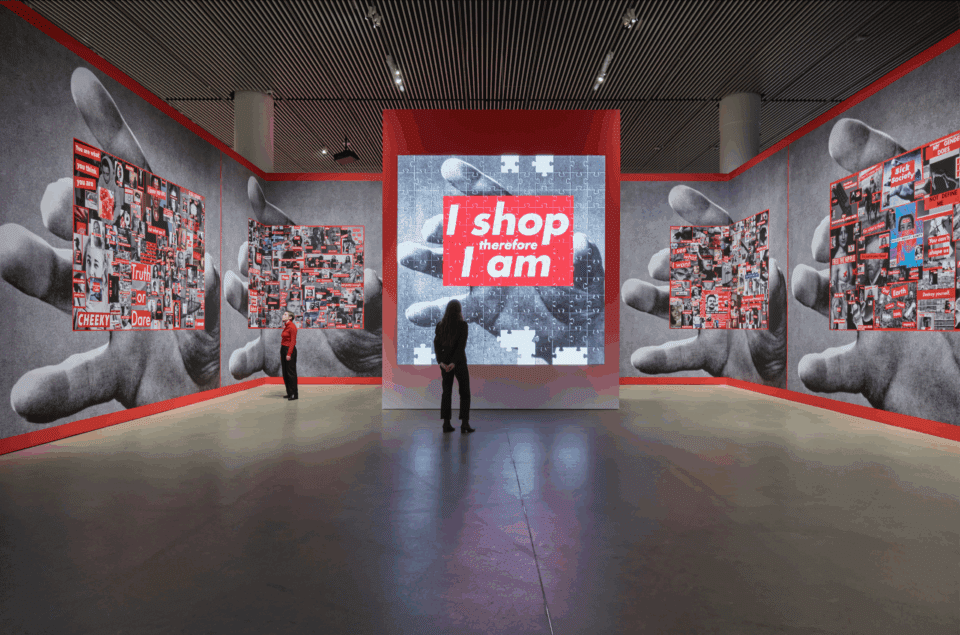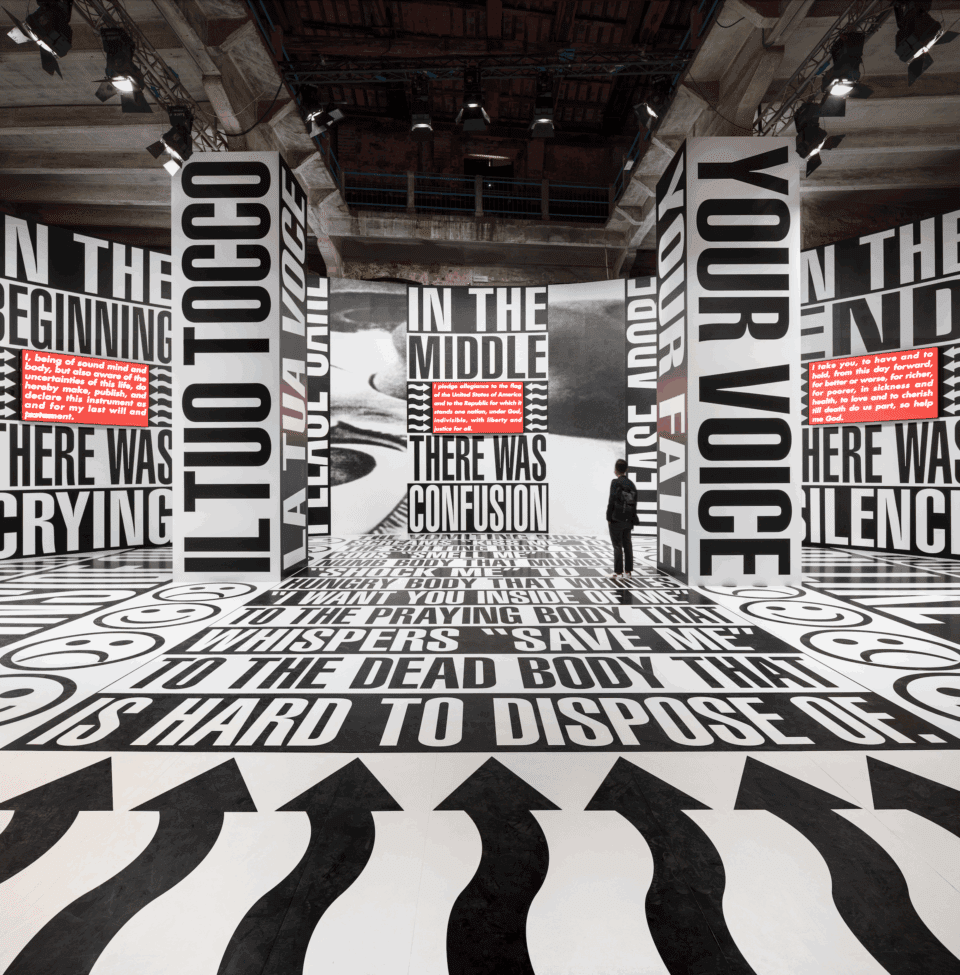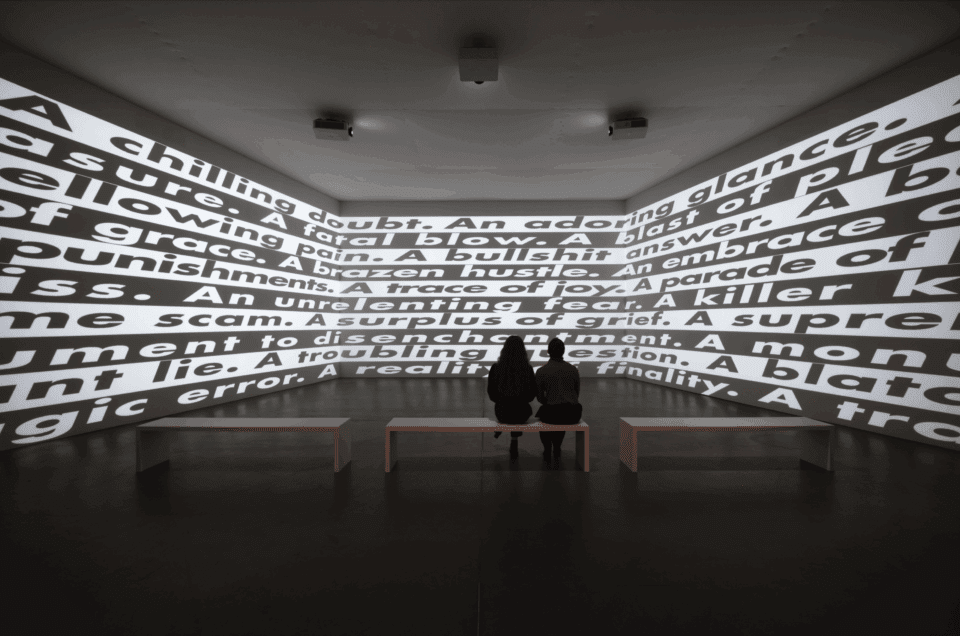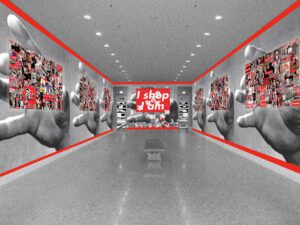Bold typography. Striking juxtapositions of image and text. Monumental scale. Barbara Kruger (b. 1945) has shaped the contemporary art scene for half a century. The artist is renowned for a distinctive visual language that both draws from, and critiques, mass media. Now, the Guggenheim Museum Bilbao presents the first comprehensive survey of the artist’s work in Spain. Another day. Another night brings together more than four decades of Kruger’s radical oeuvre, which is embedded in themes of mass communication and provides stark cultural commentary. In a world where social media, influencers and digital marketing have made it harder than ever to discern advertising from authenticity, her work continues to play a vital role in exposing the mechanisms of persuasion, consumption and control that permeate contemporary life.

Kruger’s distinctive aesthetic is deeply rooted in her career as a graphic designer. In the late 1960s, she worked as a page designer and picture editor at magazines such as Mademoiselle and House & Garden, where she learned to capture reader attention through composition and clarity of visual information. These formative experiences were pivotal to the development of Kruger’s distinctive style. They shaped her sensitivity to how images circulate in consumer culture, and saw her begin working with sans serif typefaces – most notably Futura Bold and Helvetica Ulta Compressed – valued for their stark legibility and punch. These fonts became hallmarks of her art, allowing her to “cut through the grease”, as she once put it, with declarative statements that seize space and demand engagement. From the beginning, Kruger has treated language not only as content, but as a visual element as charged as any image.

Now, the typeset transforms Guggenheim Bilbao’s galleries into an environment where sound, text and architecture converge – surrounding visitors in the language of power. The show unites the old and new, presenting iconic paste-ups alongside recent video and digital pieces. Audiences are encircled by the artist’s black-and-white visuals, faced with phrases like: “who speaks? Who is silent?”, “in the beginning, there was crying” and “your body is a battleground.” The exhibition opens with one of her most famous pieces, Untitled (I shop therefore I am), originally created in 1987 as a photographic silkscreen on vinyl and reimagined in 2019 as a large-scale LED installation. Audiences are met with a five-metre-high version of the artwork, complete with animation and sound. It unfolds like a giant puzzle, each piece locking into place until a full sentence emerges: “I shop therefore I am.” Then, in a flash, the image changes, accompanied by the sound of clanking metal, cycling through variations like “I shop therefore I hoard,” “I need therefore I shop” and “I love therefore I need.” It is a philosophical riff on consumption and identity that sets the tone for the exhibition, where references to thinkers, writers and cultural texts saturate the space.

The artist draws from a constellation of sources – political speeches, advertising, religious doctrine, internet slang – transforming them into sharp, incisive reflections on the systems that shape modern life. She doesn’t simply quote, she imbues phrases with new meaning. Kruger replaces passive consumption with confrontation, swapping out the viewer’s internal monologues for hers – probing, biting and oddly intimate. There is an urgency to the work that feels particularly pertinent in today’s climate of political and cultural tensions. One standout piece is Untitled (Forever), in which George Orwell’s ominous words – “if you want a picture of the future, imagine a boot stamping on a human face – forever” – appear in monumental text. It is a statement written decades ago, but in Kruger’s hands, feels disturbingly prescient. Elsewhere, the very nature of reality is called into question. In Untitled (Verdad), the Spanish word for truth fades from jet black to pale gray, asking: are whether facts absolute, or do they erode over time?

The show is more than a typical retrospective romp through decades of work. Instead, Kruger brings the story up to date, right onto the museum’s doorstep, with brand-new projects that engage with Bilbao’s linguistic and cultural context. Basque Country, where the city is located, straddles the border between France and Spain on the Bay of Biscay. The Basque language is the only remnant of dialects spoken in southwestern Europe before the region was Romanised in the 2nd century BC. It is a location with a complex history of identity and resistance, offering a resonant setting for Kruger’s interventions. The artist says: “language is a powerful force, and it defines us. It speaks of hierarchies, of adoration and contempt. And it has a very site-specific element to it, in that each place carries its own vernacular and embedded histories.” The result of these considerations is a new work in Basque called Untitled (Path) (2025), referencing the area’s linguistic landscape and serving as a visual thread to tie the exhibition together.

Another day. Another night is a towering achievement, as Kruger’s monumental installations guide audiences towards an alternative way of seeing. Each piece asks: what are we being told to ignore, and what should we be paying attention to? At a time when truth is contested, media is omnipresent and language itself is a battleground, Kruger’s work insists that we not simply consume – but pause, reflect and respond.
Barbara Kruger: Another day. Another night. is at Guggenheim Bilbao until 9 November 2025: guggenheim-bilbao.eus
Words: Emma Jacob
Image Credits:
1. Barbara Kruger. Untitled (Forever), 2017/2025. Digital print on vinyl. Installation view of Barbara Kruger: Another day. Another night. Guggenheim Museum Bilbao, June 24–November 9, 2025. Courtesy of the artist and Sprüth Magers.
2. Barbara Kruger. No Comment. Exhibition view, ARoS Aarhus Kunstmuseum, Aarhus, November 29, 2024–April 21, 2025. Courtesy of the artist, ARoS Aarhus Kunstmuseum, Sprüth Magers, and David Zwirner. Photo: Anders Sune Berg.
3. Barbara Kruger. Please cry / Bitte lachen. Exhibition view, Neue Nationalgalerie, Berlin, April 29–August 28, 2022. Courtesy of the artist and Sprüth Magers/Mies van der Rohe, VG Bild-Kunst, Bonn 2022. Photo: Timo Ohler.
4. Barbara Kruger. The Milk of Dreams – 59th International Art Exhibition. Exhibition view, Venice Biennale, April 23-November 27, 2022. Courtesy of the artist and Sprüth Magers. Photo: Timo Ohler.
5. Barbara Kruger. No Comment. Exhibition view, ARoS Aarhus Kunstmuseum, Aarhus, November 29, 2024–April 21, 2025. Courtesy of the artist, ARoS Aarhus Kunstmuseum, Sprüth Magers, and David Zwirner. Photo: Anders Sune Berg.
6. Barbara Kruger. No Comment. Exhibition view, ARoS Aarhus Kunstmuseum, Aarhus, November 29, 2024–April 21, 2025. Courtesy of the artist, ARoS Aarhus Kunstmuseum, and Sprüth Magers. Photo: Anders Sune Berg





